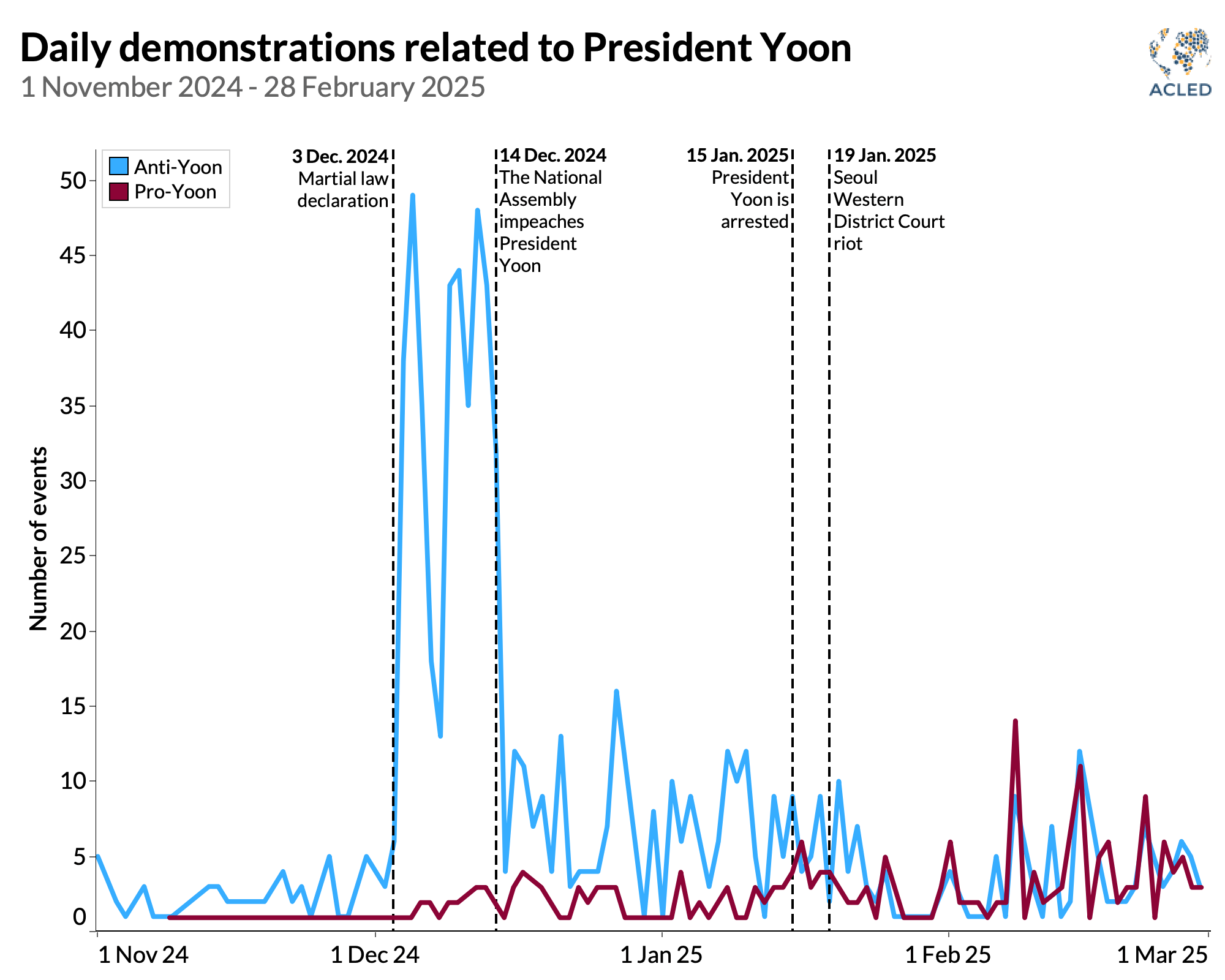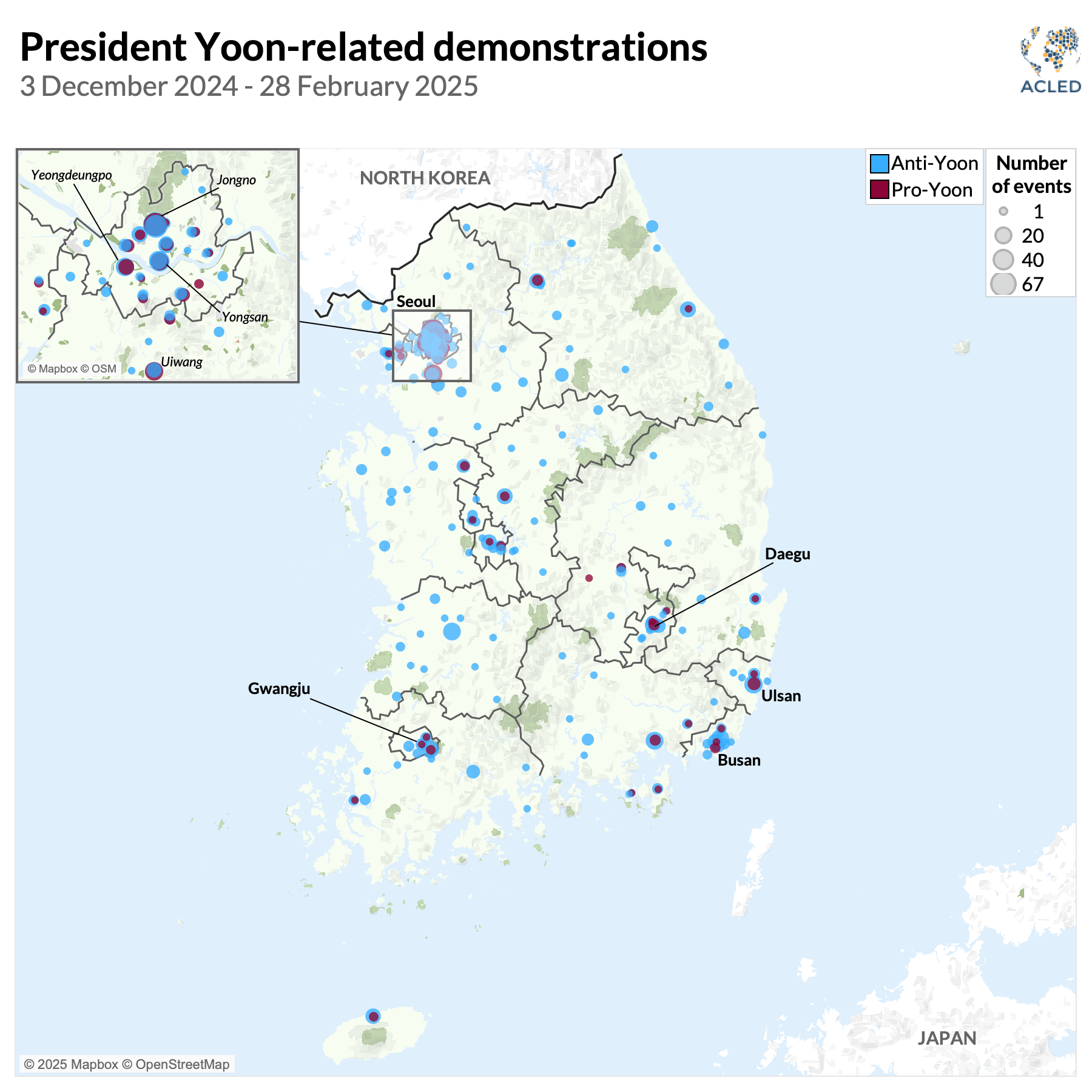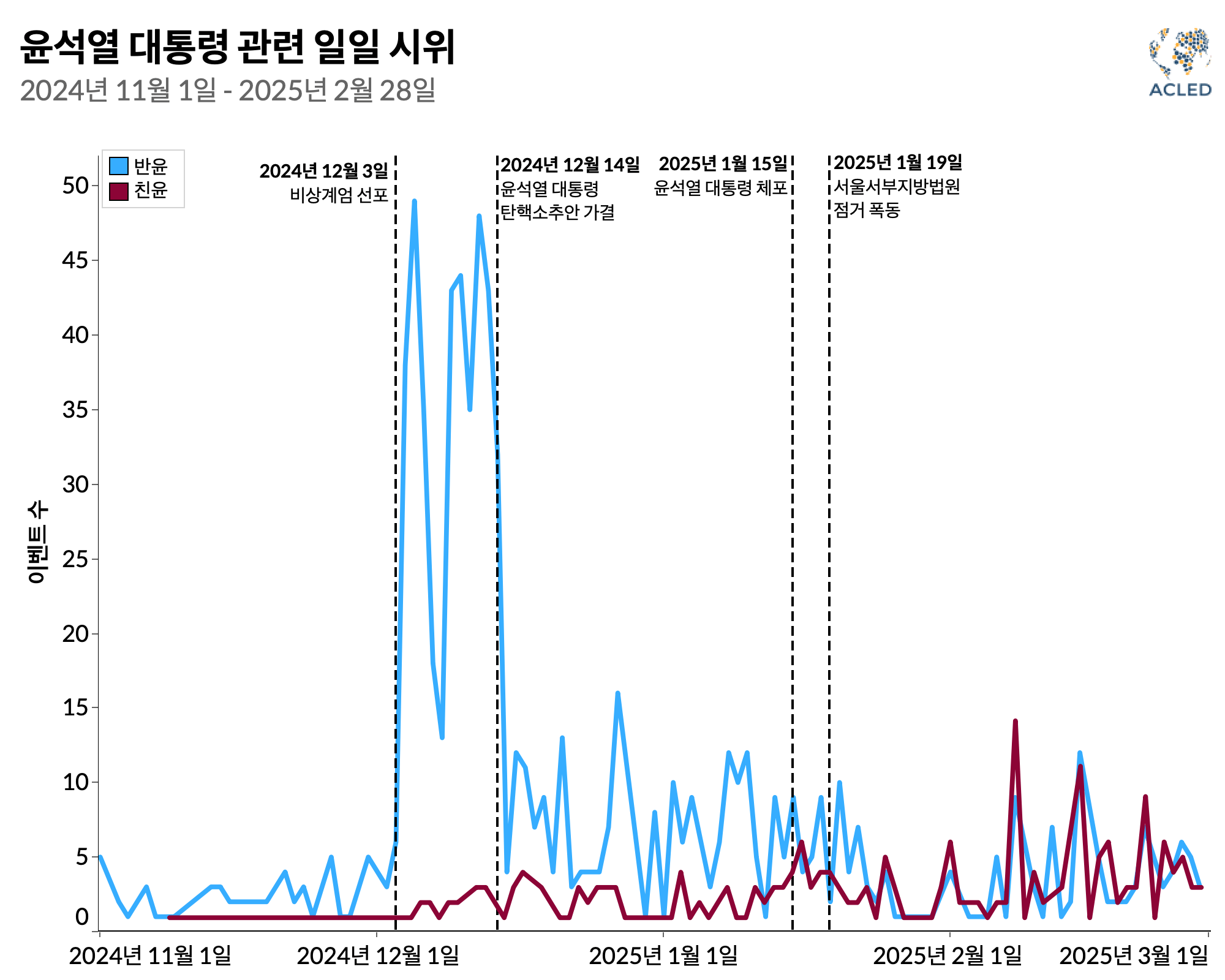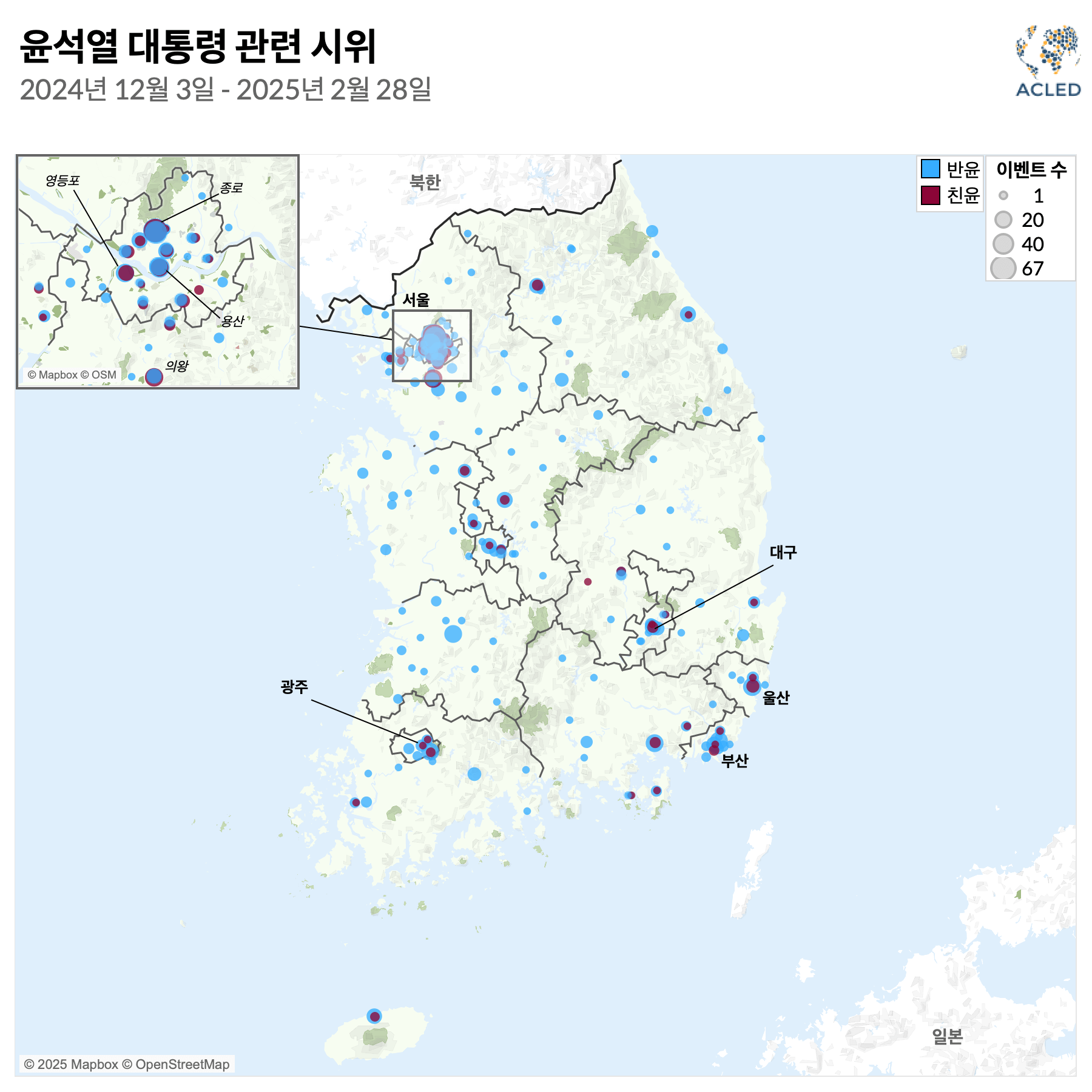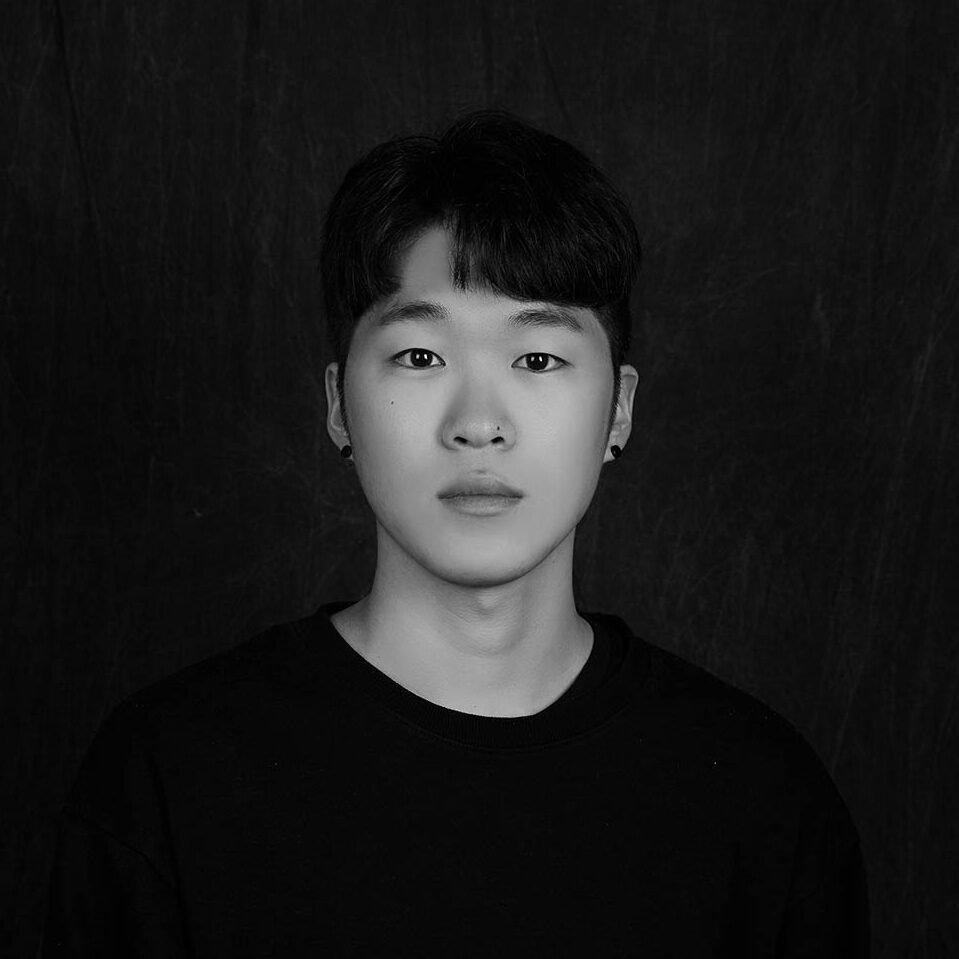
Q&A with
Hangyu Lee
East Asia Pacific Research Manager, ACLED
In this Q&A, ACLED’s East Asia Pacific Research Manager, Hangyu Lee, explains who has been participating in South Korea’s recent mass demonstrations and how protesters might react to the Constitutional Court’s verdict on whether to uphold or overturn the National Assembly’s 14 December 2024 decision to impeach President Yoon Suk Yeol. The verdict is expected around mid-March.
President Yoon declared martial law on 3 December 2024 to “immediately eradicate the unscrupulous pro-Pyongyang antistate forces” and protect South Korea’s “free constitutional order” from perceived threats.1Chea Sa-rah, “Transcript: President Yoon Suk Yeol’s speech to declare emergency martial law,” Korea JoongAng Daily, 4 December 2024 Yoon’s attempt failed when the National Assembly lifted the declaration, but following this unprecedented attempt, various protest movements converged around a single debate: whether to impeach Yoon.
Since taking office, Yoon’s administration has been plagued by multiple political scandals, including the alleged government interference in a high-profile investigation into a marine corporal’s death, poor disaster response to the Itaewon Halloween crowd crush, the suppression of labor unions and the media, and allegations against the first lady involving stock manipulation and bribery.2Park Sung-ui, “Two years after shouting ‘Judgment on Moon Jae-in,’ President Yoon Suk Yeol stands on the judgment platform,” Sisa Journal, 12 April 2024 (Korean) These controversies have stoked public anger and led to a decline in his approval ratings.3Kim In-han and Ahn Chae-won, “‘53%→23%’ President Yoon’s approval rating cut in half… Key moments when public sentiment turned away,” Money Today, 6 May 2024 (Korean) ACLED has been tracking and documenting anti- and pro-Yoon demonstrations since his inauguration on 10 May 2022.4For more information on methodology behind these data, see the ACLED Codebook on our Knowledge Base. Anti-Yoon protests peaked in December 2024 in response to Yoon’s failed martial law attempt (see graph below). Since this, ACLED records over 750 anti-Yoon protests and around 200 pro-Yoon protests.
Over the past few months, we’ve seen these protests unfold in South Korea, but what are the groups opposing Yoon?
Anti-President Yoon protesters include civil society organizations, labor unions, women’s rights organizations, environmental groups, student organizations, farmers’ groups, LGBTQ+ activists, journalists, and opposition parties. Among the most prominent umbrella groups recorded in ACLED data are Candlelight Action and BISANG Action for Yoon Out & Social Reform (BISANG Action).
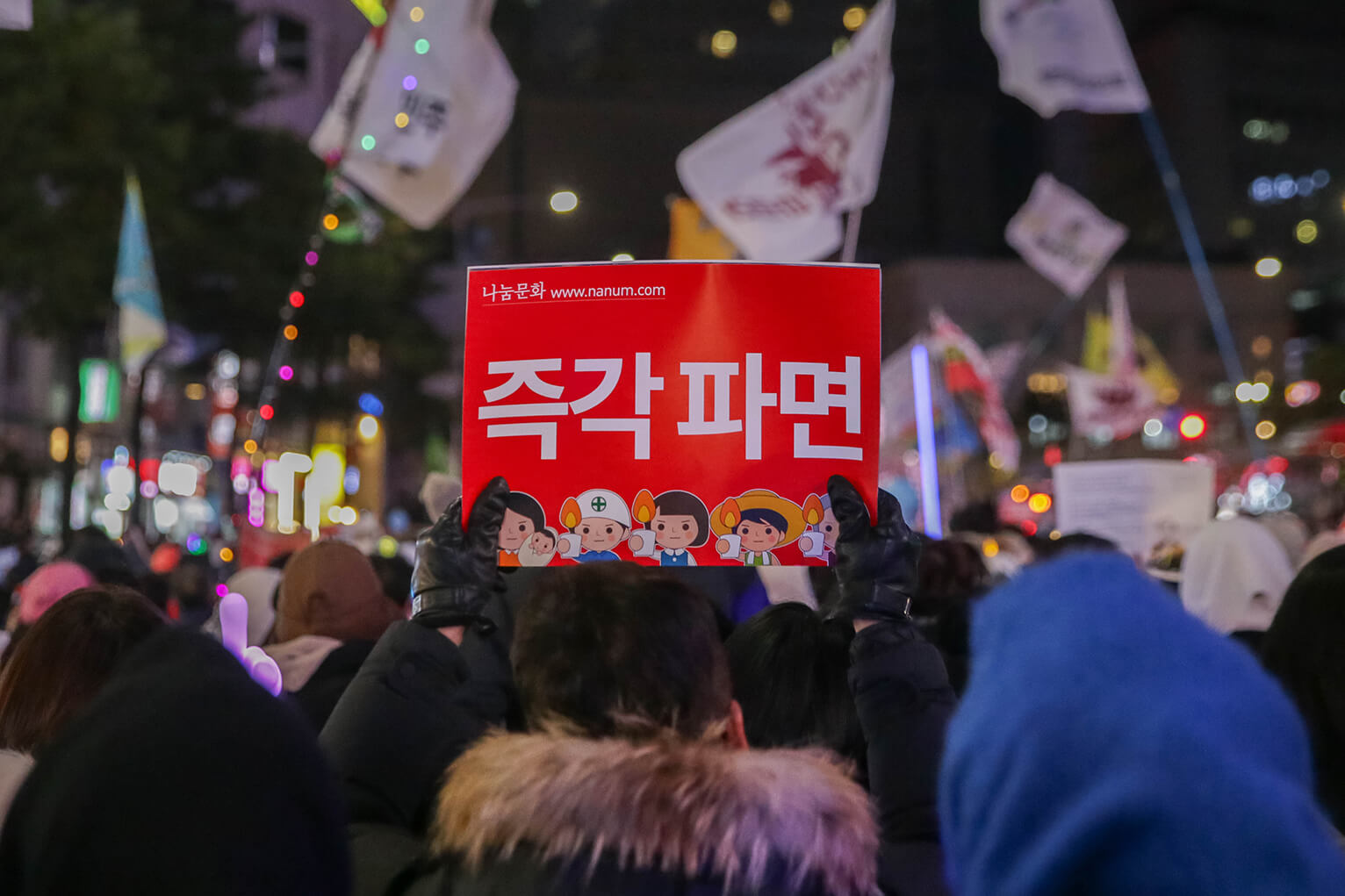
The first, Candlelight Action, is a coalition of progressive civic organizations, labor unions, political parties, and activist groups. Its mission is to push for President Yoon Suk Yeol’s resignation and drive significant social reforms in South Korea.5Go Il-suk, “One year of candlelight action…Until ‘Yoon Suk Yeol’s resignation and special probe into Kim Keon-hee,’” Mindle News, 19 April 2023 (Korean) It was first recorded participating in anti-Yoon demonstrations in 2022 and has consistently demanded Yoon’s resignation rather than just criticizing his policies since then.
The second key group, BISANG Action, was formed on 11 December 2024, after Yoon’s martial law declaration, and consists of over 1,500 civic, social, and labor organizations. It was formed to demand the immediate resignation of Yoon — whom it labels an “insurrectionist.” Their goal is to hold his accomplices accountable, restore national sovereignty, and implement major social reforms in South Korea.6Ko Na-rin, “1549 civic groups launch ‘Emergency Action for Yoon Suk Yeol’s Immediate Resignation and Social Reform,’” Hankyoreh, 11 December 2024 (Korean) The group openly denounces martial law as unconstitutional and demands Yoon’s impeachment.7Coalition for Democratic Media, “[BISANG Action for Yoon Out & Social Reform Statement] Immediately remove Yoon Suk Yeol, the destroyer of the Constitution,” 26 February 2025 (Korean) Before it was created, its member organizations had separately criticized government failures. Since its formation, BISANG Action has participated in over 110 demonstrations, averaging over one per day.
Meanwhile, the Korean Confederation of Trade Unions, one of South Korea’s two major labor federations, has also led various professional associations in the anti-Yoon protests.
We’ve also seen more pro-Yoon protests in reaction to the mass push for impeachment. Who is supporting him?
ACLED records a 61% increase in pro-Yoon demonstrations in January 2025 compared to December 2024, when President Yoon declared martial law. The movement is led by far-right civic groups, Christian organizations, the ruling People Power Party (PPP), and other conservative factions. Many of these parties and organizations have roots in the Taegukgi rallies, a series of conservative demonstrations that back former impeached President Park Geun-hye. They experienced steady growth during Moon Jae-in’s presidency and continued under Yoon’s administration in support of his government.8Park Jong-hwa “Presidential Office’s Kim Dae-nam suspected of orchestrating ‘counter-protest’ by far-right YouTubers,” Newstapa, 24 October 2024 (Korean) Many members of these factions are conservatives aged 60 and older.9Ahn Hong-ki and Lee Jong-ho, “October 3 Taegukgi rally: 62.3% were in their 60s and 70s,” OhMyNews, 9 September 2019 (Korean) These groups and parties leverage YouTube channels and Christian networks to organize rallies.10Lee Oh-seong, “After a month of being trapped in the far-right YouTube algorithm,” SisaIN, 21 Januray 2025 (Korean) PPP lawmakers frequently take part in these rallies. The far-right Liberal Unification Party (LUP), supported by the influential Sarang Jeil Church, plays a significant role as well.11Shin Da-eun, “Jeon Kwang-hoon’s election fraud claim began with ‘there’s no way the Liberty Unification Party won zero seats,’” Hankyoreh, 8 February 2025 (Korean)
Yoon’s impeachment in December 2024 and arrest on insurrection charges in January 2025 further escalated demonstrations, as his supporters see these actions as politically motivated. Right-wing media and conservative YouTube channels amplified claims of election fraud, mobilizing protests. Some demonstrators adopted foreign political symbols, such as MAGA hats and US flags, and displayed signs that said “Stop the Steal,” claiming that the 22nd National Assembly election in May 2024, where the ruling party suffered a significant defeat, was “rigged.”12Mike Valerio et al, “‘Stop the Steal’ in South Korea? Why MAGA-like hats and slogans are part of President Yoon’s impeachment drama,” CNN, 7 January 2025
This trend suggests a broader ideological alignment and an attempt to draw parallels with international political narratives. Following the martial law declaration, we’ve seen a noticeable rise in support for Yoon among young conservative men. Driven by deep distrust and hostility toward the opposition Democratic Party, many within this demographic have actively participated in rallies, expressing both support for Yoon and dissatisfaction with the current political climate.13Yoo Seong-woon, Jang Seo-yoon, and Shin Su-min, “Why silent 2030 men on Yoon’s impeachment are now rushing to the streets,” JoongAng Ilbo, 25 January 2025 (Korean)
Tensions peaked on 19 January 2025 when pro-Yoon rioters stormed the Seoul Western District Court, vandalizing property, assaulting police and journalists, and intimidating the judge who issued Yoon’s detention warrant. This unprecedented attack underscores the deepening crisis and potential for further unrest in South Korea.
Most protests seem to be taking place in the capital. Given how widespread this issue appears to be, have demonstrations also occurred in other locations?
Both pro- and anti-Yoon protests have been concentrated in Seoul, the capital. However, ACLED data show that demonstrations have taken place nationwide (see map below).
While Seoul remains the main focus, Busan, Daegu, and Ulsan have experienced large anti-Yoon protests alongside pro-Yoon gatherings despite their traditionally conservative stance. Likewise, Gwangju, known for its progressive history, has seen large-scale anti-Yoon demonstrations and pro-Yoon rallies. Some media reports suggested that pro-Yoon protesters traveled from other cities to the progressive stronghold.14Kim Sang-yoon, “DPK on the Gwangju anti-Yoon rally: ‘A gathering of outsiders mobilized by buses,’” Chosun Ilbo, 17 February 2025 (Korean)
This widespread distribution of demonstrations highlights that South Korea’s political crisis is not confined to the capital but is a deeply rooted national issue.
Do you often have pro-Yoon and anti-Yoon demonstrators out protesting simultaneously? If so, are there confrontations between them?
Yes, concurrent protests on opposing sides are common in South Korea, given the country’s dynamic political landscape and long history of mass demonstrations. While these protests, which ACLED calls counter-demonstrations, have always been a part of South Korea’s protest culture, President Yoon’s failed attempt to impose martial law has further deepened political divisions, significantly increasing counter-protests involving both progressive and conservative groups.
Only a relatively few counter-protests were recorded between Yoon’s inauguration and the martial law declaration. However, that number has increased drastically since the failed attempt. Rival pro- and anti-Yoon demonstrators have coalesced in key locations, including the Yongsan District of Seoul, where the presidential office is located; the Yeongdeungpo District of Seoul, home to the National Assembly; the Jongno District of Seoul, where the former presidential office was situated; and Uiwang, where Yoon has been detained.
This surge in counter-protests marks a new era of polarization, where opposing groups frequently confront one another, often using hostile language. While most counter-protests recorded by ACLED have remained peaceful, media reports indicate increasing verbal hostility and occasional skirmishes between demonstrators.15Seo Ji-won, “With the semester about to start, protests for and against President Yoon’s impeachment heat up with insults and physical fights near universities,” Dong-a Ilbo, 3 March 2025 (Korean)
How do you see this dynamic continuing during the impeachment trial and once we have the verdict?
Should Yoon be removed from office, his base will perceive this as unfair and politically motivated. This will likely spark further demonstrations in conservative strongholds such as Busan, Daegu, Ulsan, and parts of Seoul. Right-wing media and online communities are likely to amplify claims of electoral fraud, further fueling these reactions.
If Yoon’s supporters reject the impeachment ruling, more violent confrontations with authorities, as we saw in the Seoul Western District Court riot, could emerge, as could confrontations with anti-Yoon protesters. Counter-protests are expected to intensify until the next presidential election in May 2025, mobilizing both conservative and progressive bases in an increasingly volatile political landscape.
Hangyu Lee was speaking to ACLED Communications Coordinator, Gina Dorso, and Publications Coordinator, Niki Papadogiannaki
Q&A: 한국에서 시위를 이끄는 친윤 및 반윤 단체는 누구인가?
ACLED의 동아시아·태평양 리서치 매니저인 이한규는 이 Q&A를 통해 최근 한국에서 벌어진 대규모 시위의 주체를 짚어보고, 2024년 12월 14일 국회의 윤석열 대통령 탄핵 결정에 대한 헌법재판소의 판결이 시위에 미칠 영향을 분석한다. 헌재의 판결은 3월 중순쯤 나올 예정이다.
윤석열 대통령은 2024년 12월 3일, “파렴치한 종북 반국가 세력을 일거에 척결”하고 한국의 “자유헌정질서”를 지키겠다며 계엄을 선포했다.[1] 그러나 국회가 이를 해제하면서 윤석열 대통령의 시도는 실패로 끝났다. 이 전례 없는 시도 이후, 여러 시위가 ‘윤석열 대통령 탄핵’이라는 쟁점을 중심으로 결집했다.
윤석열 대통령 취임 이후 그의 정부는 여러 정치 스캔들에 시달려왔다. 해병대원의 사망 사건 수사에 대한 정부 개입 의혹, 이태원 핼러윈 참사 대응 실패, 노동조합과 언론 탄압, 그리고 대통령의 부인 김건희의 주가 조작 및 뇌물 수수 의혹 등이 대표적이다.[2] 이러한 논란은 국민의 분노를 불러일으키며 윤석열 대통령의 지지율 하락으로 이어졌다.[3] ACLED는 2022년 5월 10일 윤석열 대통령 취임 이후 반윤 및 친윤 시위를 추적·기록해 왔다.[4] 반윤 시위는 2024년 12월 윤석열 대통령의 계엄령 선포에 대한 반발로 정점에 달했다 (아래 그래프 참조). ACLED의 기록에 따르면, 계엄 이후 반윤 시위는 750건 이상, 친윤 시위는 약 200건 발생했다.
지난 몇 달 동안 한국에서 반윤·친윤 시위가 벌어졌는데, 윤석열 대통령의 탄핵을 요구하는 단체들은 누구인가?
윤석열 대통령의 탄핵을 요구하는 반윤 시위대에는 시민단체, 노동조합, 여성 권익 단체, 환경 단체, 학생 단체, 농민 단체, 성소수자, 활동가, 언론인, 그리고 야당 등이 포진하고 있다. ACLED 데이터에 기록된 주요 연합 단체로는 ‘촛불행동’과 ‘윤석열즉각퇴진·사회대개혁 비상행동’(비상행동)이 있다.

첫 번째 주요 단체인 ‘촛불행동’은 진보 성향의 시민단체, 노동조합, 정당, 그리고 활동가 집단으로 구성된 연합체다. 이 단체는 윤석열 대통령의 퇴진과 한국 사회의 근본적인 개혁을 목표로 한다.[5] 촛불행동은 2022년부터 반윤 시위에 참여한 것으로 기록되었으며, 단순히 윤석열 대통령의 정책을 비판하는 것을 넘어 일관되게 그의 퇴진을 요구해 왔다.
두 번째 주요 단체인 ‘비상행동’은 윤석열 대통령의 계엄령 선포 이후인 2024년 12월 11일에 결성되었으며, 1,500개 이상의 시민·사회·노동 단체로 구성되어 있다. 비상행동은 윤석열 대통령을 ‘내란범’으로 규정하며 즉각적인 퇴진을 요구하기 위해 만들어졌다. 비상행동의 목표는 윤석열 대통령의 공범들에게 내란에 대한 책임을 요구하고, 국민 주권을 회복하며, 한국 사회의 대대적인 개혁을 이루는 것이다.[6] 비상행동은 계엄령이 헌법에 위배된다고 공개적으로 비판하며 윤석열 대통령의 탄핵을 촉구하고 있다.[7] 비상행동이 결성되기 전까지 각 단체들은 개별적으로 정부를 비판해 왔다. 비상행동은 결성 이후 110건 이상의 시위에 참여해 왔으며, 하루 평균 1건 이상의 시위를 이어가고 있다.
한편, 한국의 두 주요 노동조합 연맹 중 하나인 민주노총도 반윤 시위에서 다양한 직능 단체들을 이끌고 있다.
탄핵 추진에 대한 반응으로 윤석열 대통령 지지 시위도 늘어나고 있는 듯 하다. 누가 윤석열 대통령을 지지하고 있는가?
ACLED에 따르면, 윤석열 대통령이 계엄령을 선포한 2024년 12월에 비해 2025년 1월 친윤 시위가 61% 증가했다. 이 움직임은 극우 시민단체, 기독교 단체, 집권당인 국민의힘, 그리고 기타 보수 세력에 의해 주도되고 있다. 이러한 정당과 단체들은 탄핵당한 박근혜 전 대통령을 지지하는 일련의 보수 시위인 태극기 집회에 뿌리를 두고 있다. 이들은 문재인 정부 시절 꾸준히 성장했으며, 윤석열 정부에서도 지지 활동을 이어가고 있다.[8] 이들 세력의 많은 구성원은 60세 이상의 보수층이다.[9] 이러한 단체와 정당들은 유튜브 채널과 기독교 네트워크를 활용해 집회를 조직하며,[10] 국민의힘 의원들은 이러한 집회에 자주 참여한다. 영향력 있는 사랑제일교회가 지지하는 극우 정당인 자유통일당도 중요한 역할을 하고 있다.[11]
윤석열 대통령이 2024년 12월 국회에 의해 탄핵당하고 2025년 1월 내란 혐의로 구속되면서 시위가 더욱 격화되었다. 그의 지지자들은 대통령의 탄핵과 구속에 정치적인 동기가 깔려 있다고 주장하고 있다. 보수 언론과 보수 유튜브 채널들은 선거 부정 주장을 확대하며 시위를 촉발시켰다. 일부 시위자들은 MAGA 모자와 미국 국기와 같은 외국 정치 상징을 채택하고 “Stop the Steal”(부정선거를 멈춰라)이라는 문구가 적힌 피켓을 들며, 2024년 5월의 제22대 국회 선거에서 집권당인 국민의힘이 큰 패배를 겪은 것이 “조작됐다”고 주장한다.[12]
이러한 추세는 더 넓은 이념적 일치를 나타내며, 국제 정치 내러티브와의 유사성을 끌어내려는 시도를 보여준다. 계엄령 선포 이후, 젊은 보수 남성들 사이에서 윤석열 대통령에 대한 지지가 눈에 띄게 증가했다. 야당인 민주당에 대한 깊은 불신과 적대감에 의해 다수의 젊은 보수 남성들이 집회에 적극적으로 참여하며 윤석열 대통령에 대한 지지와 현재 정치적 상황에 대한 불만을 표현하고 있다.[13]
정치적 긴장은 2025년 1월 19일, 친윤 시위자들이 서울서부지방법원을 습격하면서 최고조에 달했다. 이들은 재산을 파손하고 경찰과 기자를 폭행하며 윤석열 대통령의 구속 영장을 발부한 판사를 위협했다. 이 전례 없는 공격은 한국에서 위기가 심화하고 있으며, 추가적으로 정치적 불안이 지속될 가능성을 보여주고 있다.
대부분의 시위는 서울에서 벌어지는 것으로 보인다. 탄핵 이슈가 이렇게 광범위하게 퍼져 있는 것을 고려할 때, 다른 지역에서도 시위가 발생하고 있나?
친윤 및 반윤 시위 모두 수도인 서울에 집중되어 있다. 그러나 ACLED 데이터에 따르면, 시위는 전국적으로 전개되고 있다 (아래 지도 참조).
서울이 여전히 시위의 주요 중심지이지만, 전통적으로 보수적인 부산, 대구, 울산에서도 대규모 반윤 시위와 친윤 집회가 열렸다. 마찬가지로, 진보적인 역사로 잘 알려진 광주에서도 대규모 반윤 시위와 친윤 집회가 발생했다. 친윤 시위자들이 다른 도시에서 진보의 거점인 광주로 이동해 시위를 전개했다고 일부 언론은 보도했다.
[14]이러한 시위의 광범위한 분포는 한국의 정치 위기가 수도에 국한된 것이 아니라 깊이 뿌리내린 국가적 차원의 문제임을 보여준다.
친윤 시위대와 반윤 시위대가 동시에 시위하는 경우가 자주 있는가? 만약 그렇다면, 이들 사이에 대치가 있는가?
한국에서는 반대 입장의 시위가 동시에 이루어지는 경우가 흔하다. 이는 한국의 역동적인 정치 환경과 대규모 시위의 오랜 역사 때문이다. ACLED가 ‘맞불 시위’라고 부르는 이러한 시위는 항상 한국 시위 문화의 일부였다. 하지만, 윤석열 대통령의 계엄령 강행 실패로 한국의 정치적 분열이 더욱 심화하였고, 진보와 보수 집단 모두를 포함한 맞불 시위가 많이 증가하게 되었다.
윤석열 대통령의 취임 이후부터 그의 계엄령 선포 사이에는 상대적으로 적은 수의 맞불 시위가 기록되었다. 그러나 계엄 이후 그 이후로 맞불 시위의 수는 급격히 증가했다. 친윤 시위자와 반윤 시위자는 서울의 주요 지역, 즉 대통령실이 위치한 용산구, 국회가 있는 영등포구, 청와대가 자리 잡은 종로구, 그리고 윤석열 대통령이 구금된 의왕시에 모여들었다.
맞불 시위의 급증은 적대적 집단의 대립과 혐오 표현의 사용이 일반화된 새로운 양극화 시대를 보여준다. ACLED에 의해 기록된 맞불 시위는 대부분 평화롭게 진행되었지만, 언론 보도에 따르면 시위자들 간의 언어적 적대감이 증가하고 가끔 충돌이 발생하고 있는 것으로 나타났다.[15]
탄핵 재판 동안과 판결이 나고 난 뒤, 이 동력이 어떻게 계속될 것이라고 보는가?
윤석열 대통령이 탄핵당한다면, 그의 지지층은 이를 불공정하고 정치적 동기가 있는 것으로 인식할 것이다. 이는 부산, 대구, 울산, 그리고 서울의 일부와 같은 보수적인 지역에서 추가적인 시위를 촉발할 가능성이 높다. 보수 언론과 온라인 커뮤니티는 선거 부정 주장을 확대하여 이러한 반응을 더욱 부추길 것으로 보인다.
윤석열 대통령의 지지층이 탄핵 판결에 승복하지 않는다면, 서울서부지방법원 폭동에서 보았던 것처럼 당국과의 더욱 격렬한 대치가 발생할 수 있으며, 반윤 시위자들과의 대치도 있을 수 있다. 맞불 시위는 2025년 5월 차기 대통령 선거까지 더욱 격화될 것으로 예상되며, 정치적 불안정성이 커지면서 보수와 진보 양측 모두 지지층 결집에 나설 것으로 전망된다.
[1] 손국희, “[전문]尹대통령, 비상계엄 선포 ‘종북세력 척결, 자유 헌정질서 지킬 것,'” 중앙일보, 2024년 12월 3일
[2] 박성의, “‘文심판’ 외친 후 2년, 심판대 위에 선 尹대통령,” 시사저널, 2024년 4월 12일
[3] 김인한, 안채원, “‘53%→23%’ 반토막 난 윤 대통령 지지율…민심 떠난 결정적 장면들,” 2024년 5월 6일
[4] 이 데이터의 방법론에 대한 자세한 내용은 당사 지식 베이스의 ACLED 코드북 (영문) 을 참조하세요.
[5] 고일석, “촛불행동 1년…”윤석열 퇴진·김건희 특검” 끝까지 간다,” 민들레, 2023년 4월 19일
[6] 고나린, “1549개 시민단체 ‘윤석열 즉각퇴진·사회대개혁 비상행동’ 발족,” 한겨레, 2024년 12월 11일
[7] 민주언론시민연합, “[윤석열즉각퇴진·사회대개혁 비상행동 의견서] 헌법파괴자 윤석열을 즉각 파면하라,” 2025년 2월 26일
[8] 박종화, “대통령실 김대남, 극우 유튜버 ‘맞불 집회’ 사주한 의혹,” 뉴스타파, 2024년 10월 24일
[9] 안홍기, 이종호, “10.3 태극기 집회, 60~70대가 62.3%,” 오마이뉴스, 2019년 9월 9일
[10] 이오성, “극우 유튜브 알고리즘 한 달 동안 빠져보니,” 시사인, 2025년 1월 21일
[11] 신다은, “전광훈 부정선거 출발은 ‘자유통일당이 0석일 리 없어,'” 한겨레21, 2025년 2월 8일
[12] 박수림, “극우 ‘부정선거 망토’ 입고 마트까지 진출…국힘갤 좌표 찍고 폭언·욕설,” 오마이뉴스, 2025년 2월 6일
[13] 유성운, 장서윤, 신수민, “尹 탄핵 침묵하던 2030 남성…왜 뒤늦게 거리로 몰려나오나,” 중앙일보, 2025년 1월 25일
[14] 김상윤, “野, 광주 반탄 집회에 ‘버스 동원한 외지인 집회,'” 조선일보, 2025년 2월 17일
[15] 서지원, “개강 코앞인데 욕설에 몸싸움…대학가 尹탄핵 찬반 시위 과열,” 동아일보, 2025년 3월 3일
이 Q&A는 ACLED 동아시아·태평양 리서치 매니저 이한규가 ACLED 커뮤니케이션 코디네이터인 Gina Dorso 및 퍼블리케이션 코디네이터인 Niki Papadogiannaki와 대화한 내용입니다.

